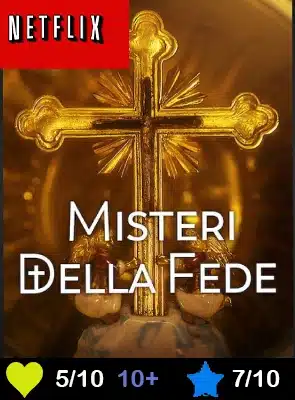MYSTERIES OF FAITH
A Netflix TV series, in the form of a documentary, on the history and devotion of some of the world's most famous relics related to the Catholic religion: Holy Grail, Crown of Thorns, Holy Face of Manoppello, fragments of the Holy Cross, shirt of Blessed Rosario Angelo Livatino. Available on Netflix
Valori Educativi
Pubblico
Giudizio Artistico
Our Review
In the TV series presentation we read, “With unprecedented access to sacred sites around the world, ‘Mysteries of Faith’ explores the secrets of Christianity’s most legendary treasures.” With this we expected to see something unprecedented, but the anticipation-which kept us tethered to the screen-was ultimately not only unrewarded, but also disappointed.

In these first four episodes, some of the relics that are part of the Catholic world (not even among the most important ones, although among them, some excellent ones are pointed out) are presented in a way that is not even too logical as well as confusing (something that is presented in the first two episodes is then taken up in the last one): Holy Grail, Crown of Thorns, Holy Face of Manoppello, fragments of the Holy Cross, bloody shirt of Blessed Rosario Angelo Livatino.
In the Catechism of the Catholic Church, in No. 1674, we read the following: “In addition to the liturgy of the sacraments and sacramentals, catechesis must take into account the forms of piety of the faithful and popular religiosity. The religious sense of the Christian people, in every age, has found its expression in the various forms of piety that accompany the sacramental life of the Church, such as the veneration of relics, visits to shrines, pilgrimages, processions, the ‘Way of the Cross,’ religious dances, the Rosary, medals, etc.”. Certainly the much-anticipated Netflix series was not intended to be a catechesis, but that does not detract from the fact that it completely lacks the scientific characters we would expect from a documentary.
There is terminological approximation (confuses faith, mystery, history, legend in addition to other concepts scattered throughout the narrative), little factual accuracy (reports errors: e.g., for the finding of the relics of the Holy Cross by St. Helena in Jerusalem, it is recounted that a corpse was used to attest to its authenticity, whereas, it was sick people), inability to present a contradiction to theses universally recognized as erroneous (the Carbon 14 evidence for the dating of the Holy Shroud by all, today, is discarded having, the sacred linen, suffered contamination from the fires to which it was exposed and whose traces are clearly visible to all).
To these elements we add the confusion regarding the presentation of multiple relics for the same reality. In the case of the Holy Grail, it is not said, most recently, that with the visits of Popes St. John Paul II and Benedict XVI to the cathedral in Valencia, Spain (where they also celebrated Mass using that distinguished relic) the Church gave a clear indication as to which was considered authentic in spite of the others, in addition, then, to completely dismantling the veracity of some relics as happens with the Manoppello Face (presented without any contradiction whatsoever) and the aforementioned Holy Shroud, which was venerated by the same Popes mentioned above and by Pope Francis.
Probably the only positive element we can welcome is the showing of the faith of the simple, of the little people, presented through testimonies collected throughout the series: we accept this as a positive point because nowadays any religious manifestation is increasingly outlawed (think, for example, of the processions visible in the TV series), but we note its clear imbalance in favor of devotionalism, mysticism if not even-as in the habit of wearing a crucifix around the neck-of superstition, as the crucifix is reduced to a good luck amulet.
There is no doubt that something much more serious and scholarly was expected, perhaps accompanied by theological advice that was probably missing: the very presentation made by some of the clergy members interviewed, seems to be instrumentalized for the purposes of the series to the point that the “Vatican” is spoken of as if it were an organization aimed at spreading waffle and historical falsehoods, without in the least helping the viewer to understand how archaeological science itself is quite modern and, therefore, very poor in documents aimed at preserving the historiographical memory of objects or realities that have accompanied the lives of the faithful for centuries.
Finally, we emphasize the excessive (exaggerated) reference to the concept of “legend” to explain origin and devotion to relics. It seems to us truly ungenerous and somewhat perplexing to resort to this conceptual category that, in fact, clashes with the historical-architectural evidence that even today is the most excellent manifestation of something that could hardly be considered to have originated from a fable.
Autore:


There are no reviews yet.